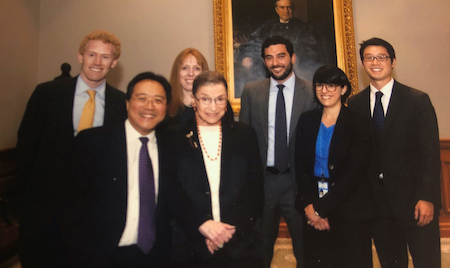Teaching was one of Ginsburg's many strengths, say former students and clerks

Devi Rao, second from right, when she was a law clerk, is pictured with the late U.S. Supreme Court Justice Ruth Bader Ginsburg and cellist Yo-Yo Ma, at left, who came to the court to perform.
Before Ruth Bader Ginsburg was appointed to the federal bench, she argued and won several landmark gender discrimination cases before the U.S. Supreme Court—in spite of the justices all being men who sometimes made flippant remarks about gender during her oral arguments.
In reflection, the late U.S. Supreme Court justice and former law professor, who died in September, often said her work during oral arguments was not unlike that of a kindergarten teacher, calmly encouraging the court to think about how they would feel if a loved one experienced something like her clients had.
In her last U.S. Supreme Court case, Duren v. Missouri, which centered on the practice of automatically exempting women from jury duty, Justice William Rehnquist asked her during oral arguments if she’d settle for Susan B. Anthony on the new dollar. His comment was met by snickers from the court.
“Because the judges didn’t think sex discrimination existed, one of the things I tried to plant in their minds was ‘Think about how you would like the world to be for your daughters and granddaughters,” Ginsburg said in RBG, the 2018 documentary about her life.
Indeed, when Ginsburg was an undergraduate at Cornell University, she was interested in being a high school teacher, says Judith Areen, executive director and CEO of the Association of American Law Schools.
“Cornell raised her sights to think about law school. I think she viewed teaching as part of her commitment; she was teaching a nation if you will,” says Areen, a former dean of Georgetown University Law Center. She got to know Ginsburg when she was a U.S. Court of Appeals for the District of Columbia Circuit judge, and her husband, Martin Ginsburg, was a professor at Georgetown Law.
People who took Ginsburg’s classes remember her as a talented law professor, who took a genuine interest in them. She joined the faculty of Rutgers University Law School in 1963 as an assistant professor, and in 1971 was a lecturer at Harvard Law School, where she taught the school’s first course on women’s rights, according to a 2004 Columbia Law Review article written by Herma Hill Kay.
Alice Richmond, a 1972 Harvard Law School graduate and chair of the ABA Journal Board of Editors, was one of Ginsburg’s students.
“The overall impression all of us had was we were in the presence of someone who was extraordinary. A lot of the professors at Harvard are very smart, but here was this person who was not only very smart but nice. She would ask us questions about our lives, which the other professors never did,” says Richmond, a Boston lawyer.
The class often discussed the 14th Amendment and the idea that gender discrimination was a more powerful concept if you showed it supported stereotypes for women and men, she adds.
 Justice Ruth Bader Ginsburg with her former clerk Devi Rao and Devi’s baby.
Justice Ruth Bader Ginsburg with her former clerk Devi Rao and Devi’s baby.
Ginsburg assisted other lawyers with that concept, too. William J. Kilberg, a Gibson, Dunn & Crutcher partner, met her in the early 1970s when he served as the associate solicitor of labor for Labor Relations and Civil Rights during President Richard M. Nixon’s administration. She was starting the ACLU Women’s Rights Project, and he got to know her while drafting revised regulations that added women to federal contractor goals for minority workers.
“She certainly helped us to find what our objective was, and she helped us think about what we were doing,” says Kilberg, who considered the justice to be a good friend and credits her with leading social change in the country.
Her response, he adds, was always that courts don’t lead social change, but they can avoid holding it back.
In 1972, Ginsburg joined Columbia Law School, where she was the first tenured female law professor. She stayed there until 1980, when she was appointed to the federal bench. In 1993 she was appointed to the U.S. Supreme Court.
Ginsburg had a computer in her chambers, but did all of her editing on paper, say her former U.S. Supreme Court clerks. They were instructed to print out their writing in a triple-spaced format to ensure room for pencil edits.
“She wouldn’t just give you her revisions. She would sit down with you and line by line explain why she made revisions,” says Devi Rao, a Supreme Court and appellate counsel at the MacArthur Justice Center, who clerked for Ginsburg during the 2013-2014 term.
“You knew it was bad when she had to get out the scissors,” jokes Elizabeth Prelogar, explaining that for major writing revisions the justice would cut paragraphs out in blocks and move them around.
A Cooley law partner who clerked for Ginsburg during the 2009-2010 term, Prelogar says the justice would drop off handwritten notes outlining her initial thoughts for an opinion’s structure.
“It might be the opening paragraph of the opinion and how she was planning to structure it. It didn’t include too much information, and it always got to the heart of the matter very plainly,” explains Prelogar, who served as an assistant special counsel under Robert Mueller in the investigation of links between the Russian government and individuals associated with President Donald Trump’s first presidential campaign.
“If you had a different view and wanted to push back, she welcomed it. She viewed it as a collaborative process, and her goal was to write the best opinion possible,” Prelogar adds.



